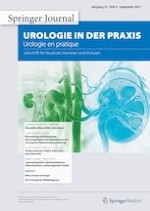Erschienen in:

25.05.2021 | Urologie | Originalien
Behandlung rezidivierender Harnwegsinfekte bei PatientInnen mit neurogener Blasenfunktionsstörung
verfasst von:
Julia Neuenschwander, Prof. Dr. med. Jürgen Pannek
Erschienen in:
Urologie in der Praxis
|
Ausgabe 3/2021
Einloggen, um Zugang zu erhalten
Zusammenfassung
Harnwegsinfekte (HWI) gehören zu den häufigsten Komplikationen bei PatientInnen mit neurogener Funktionsstörung des unteren Harntrakts. Sie sind mit einer erhöhten Morbidität, Mortalität und einer verschlechterten Lebensqualität assoziiert. Zu den Risikofaktoren gehören eine suboptimal eingestellte Blasenfunktion und die Verwendung von Kathetern. Nur symptomatische Infekte sollten behandelt werden, die Therapie einer asymptomatischen Bakteriurie ist nicht indiziert, und somit ist ein Screening nicht sinnvoll. Die Symptome eines HWI können unspezifisch und anders als bei Personen ohne neurologische Grunderkrankung sein. Vor Therapiebeginn sollte eine Urinkultur angelegt werden, und es sollte, wenn immer möglich, resistenzgerecht therapiert werden. Rezidivierende HWI sind häufig; eine antibiotische Prophylaxe sollte wegen der geringen Effektivität und der Begünstigung multiresistenter Keime möglichst vermieden werden. Es existieren verschiedene nichtantibiotische Alternativen; da jedoch für kein Verfahren ein evidenzbasierter Wirknachweis besteht, ist ein individuelles Vorgehen mit Modifikation der Prophylaxe nach klinischem Verlauf erforderlich.